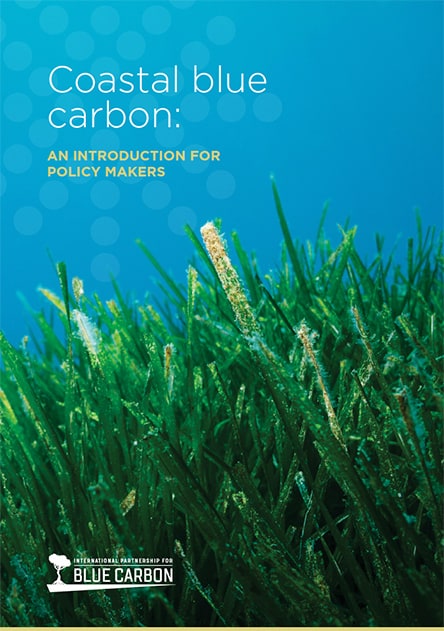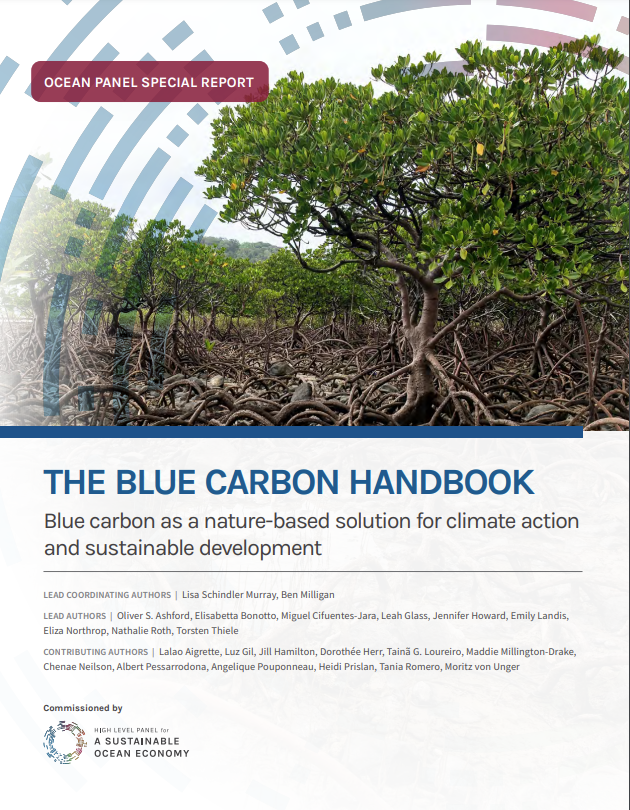Coastal Blue Carbon Ecosystems in International Frameworks and Conventions Overview Report
An overview of the main international frameworks and conventions that address the conservation, restoration, and sustainable use of coastal blue carbon ecosystems. Some of these frameworks and conventions specifically include coastal blue carbon ecosystems as part of their Parties’ commitments, while others guide action towards objectives that are interconnected with coastal blue carbon ecosystems, such as the conservation of critical habitats and specific ecosystem types.
Inventory of Global Blue Carbon Actors
The Inventory lists the main players in the blue carbon field, categorized by type of organization – intergovernmental organization, non-governmental organization or global initiative. The organizations listed in the document work primarily at the global or regional level.
Coastal blue carbon: an introduction for policy makers
The introduction to blue carbon for policy makers describes some of the challenges and opportunities in developing policies and undertaking projects to protect and restore coastal blue carbon ecosystems, while highlighting work already underway. It is hoped the document will serve as a reference for those who are new to blue carbon and those who are seeking to bring a greater focus on blue carbon in their jurisdictions.
The Blue Carbon Handbook: Managing blue carbon as a nature-based solution for supporting sustainable development
The handbook was developed to provide decision-makers with a broad understanding of blue carbon, and to help support decision-making and project implementation. It covers topics ranging from the sequestration potential of different blue carbon ecosystems to the policy landscape surrounding blue carbon and the carbon market and other financing options for blue carbon projects.
OTHER RESOURCES
| ID | Title | Content | Image | Date | Categories | Link |
|---|---|---|---|---|---|---|
| 10107 | Harmonizing Blue Carbon Accounting Protocols for Coastal Ecosystems in the East Asian Seas Region | This paper written by Kristina di Ticman is a foundational document on the blue carbon accounting component aimed at developing a harmonized blue carbon accounting protocol in the East Asian Seas region. The proposal to develop a harmonized blue carbon accounting protocol was agreed at the 2nd General Assembly of the PEMSEA Network of Learning Center. The paper provides a review and comparative analysis of blue carbon accounting protocols from various countries, namely China, Indonesia, Japan, the Philippines and RO Korea, alongside the voluntary standards set by VERRA, a leading a non-profit organization that develops and manages standards for sustainable development, climate action, and responsible business practices.
| 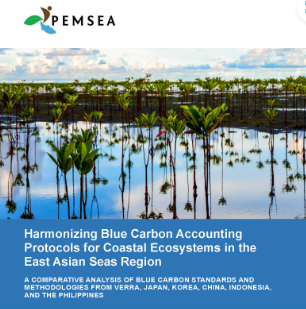 | 2025/02/17 | Paper | More information |
| 9663 | IPBC Dialogue Summary Report 2024 | The sixth IPBC Dialogue was held on 1-4 October 2024 at Cairns Convention Centre in Australia | 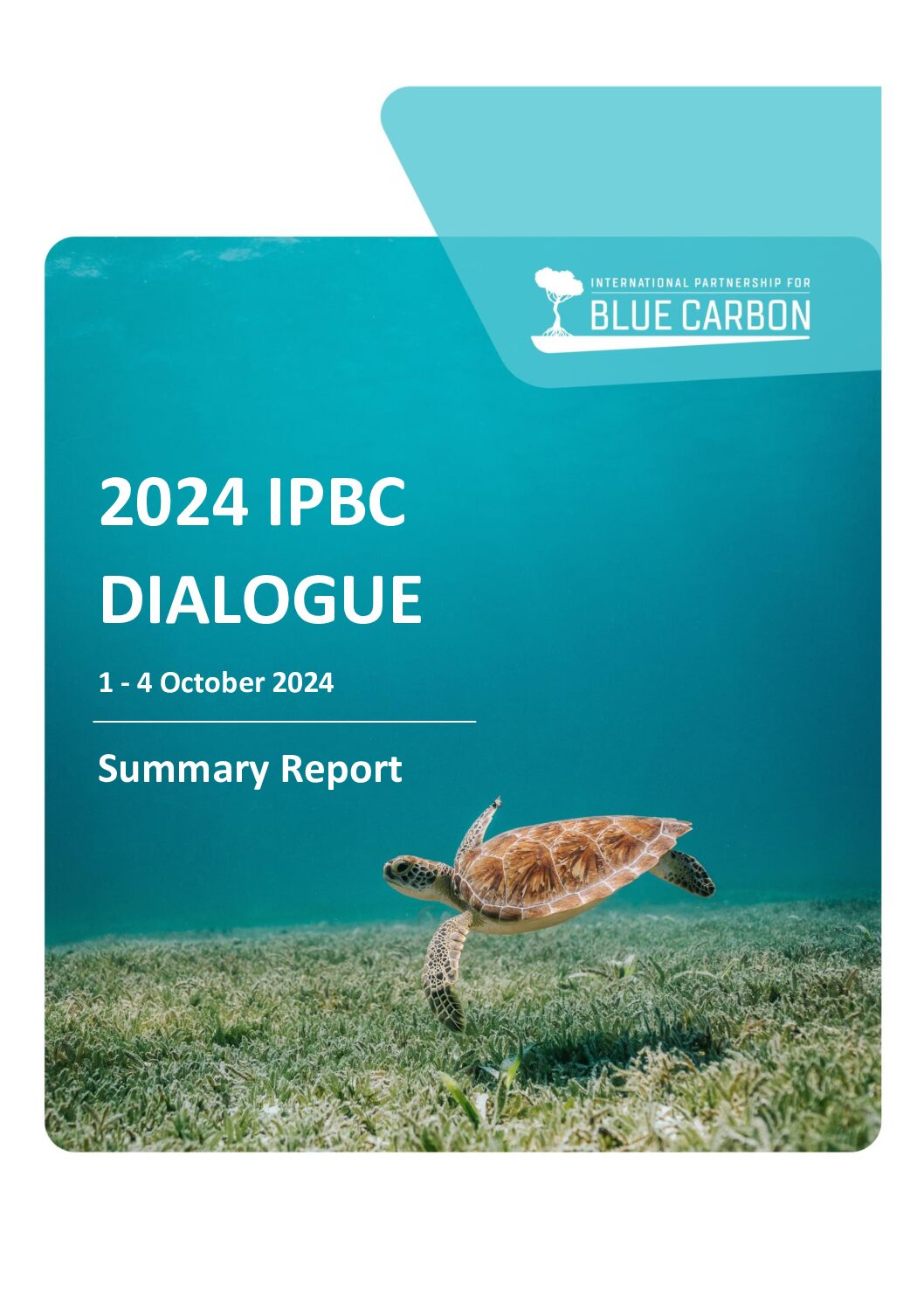 | 2024/12/20 | Conference proceedings, Paper | More information |
| 4630 | IPBC Knowledge Exchange #3 – How and Why to include blue carbon in NDCs | This one hour video brings together leading experts, policymakers and practitioners to explore the multifaceted aspects of integrating blue carbon ecosystems into NDCs, guided by the recently published ‘Blue Carbon and Nationally Determined Contributions: Guidelines on Enhanced Actions.” |  | 2023/12/15 | Video | |
| 4472 | Blue Carbon Foundations Course | The Blue Carbon Foundations Course equips you with the knowledge and skills to understand blue carbon and its relevance to you. The course covers blue carbon science, policy, economics, and other concepts including livelihoods, adaptation, resilience, and communications. The course is delivered over eight modules, including an introduction to blue carbon ecosystems, related international frameworks, treaties, conventions and agreements, national policy integration, MRV, climate and market finance, project outcomes, communication, and implementation.
| 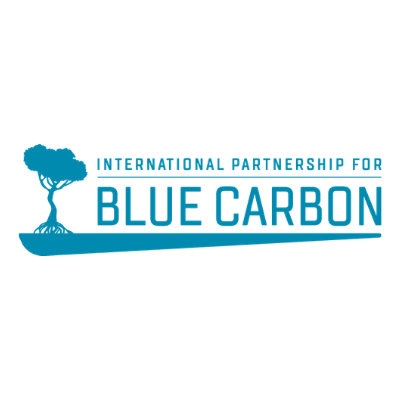 | 2023/12/11 | Website | |
| 4250 | Actionable Blue Carbon Ecosystems for Climate Mitigation and Adaptation | As an update to the earlier version published in 2021, this policy brief outlines the blue carbon ecosystems that are currently ‘actionable’ for climate mitigation, based on the best available science and existing management practices. Additionally, this policy brief identifies the ecosystems that are ‘emerging’ and may become actionable in the future (macroalgae, benthic sediments and mudflats), as well as ecosystems that do not currently have a mitigation pathway but offer other critical benefits for climate adaptation and resilience, biodiversity, and livelihoods (such as coral reefs, oyster reefs and marine fauna). This brief does not consider climate mitigation options that move ecosystems further from their natural state and have possible negative impacts on human health and wellbeing, such as kelp afforestation and ocean fertilization. Non-ecosystem-based options for ocean carbon dioxide removal (CDR) are also not considered in this brief. |  | 2023/12/04 | Policy brief | More information |
| 3880 | Best Practice Guidelines for Mangrove Restoration | The Best Practice Guidelines for Mangrove Restoration brings together the latest accumulated local and scientific knowledge about mangrove restoration best-practices into one comprehensive resource. The aim is to align mangrove practitioners, NGOs, governments, scientists, industry, local communities, and funders around accepted best-practices for science-based and inclusive mangrove restoration. |  | 2023/11/21 | Website | |
| 3879 | Blue Carbon Project Enabling Conditions Map | The Blue Carbon Enabling Policy Conditions map shows the status of national policies related to blue carbon policy development in 21 mangrove countries. Fair Carbon reviews existing legislation, land tenure and carbon rights frameworks, and ongoing policy developments in mangrove countries to identify challenges to project development. This map is meant to help voluntary blue carbon market projects assess feasibility, and determine if projects require additional time and labor overcome legislative or policy hurdles. |  | 2023/11/21 | Website | |
| 3878 | Blue Carbon 101 Course | The Blue Carbon 101 course explains how carbon markets work, from what a “carbon credit” is, through how they are produced and traded, and why some sell for higher prices than others. It includes chapters on Introduction to Mangrove Ecosystems, Greenhouse Gases, Carbon Sequestration and Storage, Blue Carbon Offsetting, Implementing Mangrove Carbon Projects, Article 6 and NDCs. |  | 2023/11/21 | Website | |
| 3771 | Blue Carbon Nationally Determined Contributions | Nationally Determined Contributions (NDCs) contain the strategies and targets of countries worldwide to mitigate and adapt to climate change. Activities to reach their goals are widespread and range from scaling-up renewable energy infrastructure to restoring carbon storing ecosystems such as forests, mangroves, or blue carbon ecosystems. The inclusion of blue carbon ecosystems in NDCs indicates the country’s intention to accelerate the conservation and restoration of mangroves, seagrass, and salt marsh. |  | 2023/11/16 | Website | |
| 3770 | Global Blue Carbon Project Map | The Fair Carbon blue carbon project map allows easy discovery of publicly registered blue carbon projects across multiple voluntary carbon market registries. Projects in development, undergoing validation and fully accredited are all shown. Pre-registration and concept stage sites are omitted unless the project proponent specifically requests inclusion. |  | 2023/11/16 | Website | |
| 3406 | IPBC Overview Report on Coastal Blue Carbon Ecosystems in International Frameworks and Conventions – Sept 2023 | This document provides an overview of the main international frameworks and conventions that address the conservation, restoration, and sustainable use of coastal blue carbon ecosystems. Some of these frameworks and conventions specifically include coastal blue carbon ecosystems as part of their Parties’ commitments, while others guide action towards other objectives that are strictly interconnected with coastal blue carbon ecosystems, such as the conservation of critical habitats and specific ecosystem types. |  | 2023/10/04 | Policy brief | More information |
| 3168 | Decades of Mangrove Forest Change: What Does it Mean for Nature, People and the Climate? | 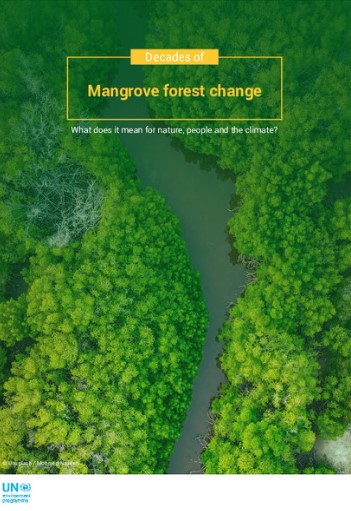 | 2023/05/10 | Paper, Website | ||
| 3165 | Into the Blue – Securing a Sustainable Future for Kelp Forests | 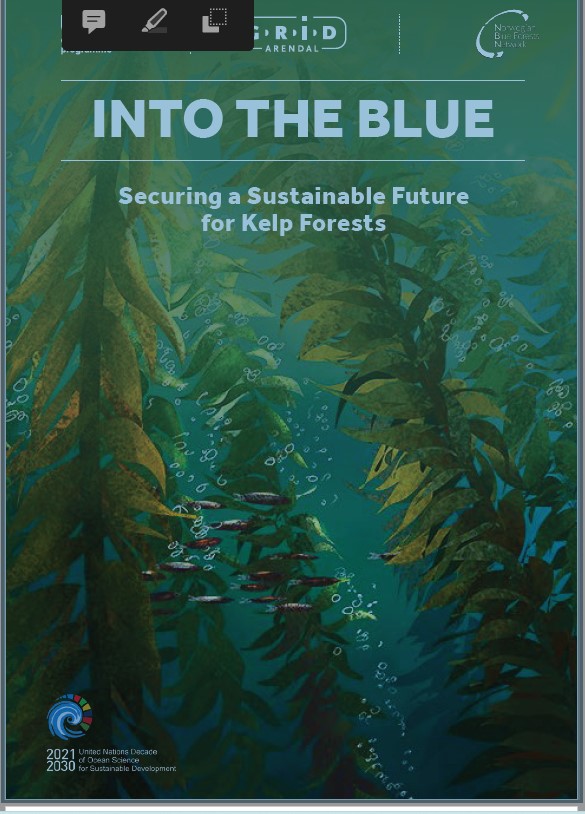 | 2023/05/10 | Report | More information | |
| 3134 | IPBC Dialogue 2023 Summary Report |  | 2023/04/24 | Conference proceedings, Report | More information | |
| 2597 | Coastal Blue Carbon Ecosystems in International Frameworks and Conventions: Overview Report |  | 2023/01/08 | Report | ||
| 2800 | Blue Forest Finance | The nations of the Indian Ocean host a substantial proportion of the world’s blue forests and meadows (for example, together they contain almost half of the world’s mangrove forests), but they also include hotspots where the rate of loss of these ecosystems is greatest. |  | 2022/12/05 | Report | More information |
| 2590 | Preserving mangroves in Indonesia | With Dr. Frida Sidik, a researcher at the Ministry of Marine Affairs and Fisheries, Indonesia. |  | 2022/01/08 | Podcast | |
| 2582 | Implementation of blue carbon offset crediting for seagrass meadows, macroalgal beds, and macroalgae farming in Japan | A review of three blue carbon offset credit projects for seagrass meadows, macroalgal beds, and macroalgae farming implemented in Japan. |  | 2022/01/08 | Paper | |
| 2575 | Introductory Training on Blue Carbon | This training module provides participants with an introduction to the concept of blue carbon, or the carbon stored and sequestered by coastal marine habitats such as seagrass beds, mangroves, and tidal saltmarshes. |  | 2022/01/08 | Website | |
| 2574 | Mangrove Mapping for Technicians and Managers | Two self-paced modules (Mangrove Mapping for Managers; Mangrove Mapping for Technicians) developed by the Commonwealth Secretariat tailored towards Commonwealth government officials and citizens with an interest in learning about: Why map mangroves; The importance of mapping for policy development; Functionality of GIS mapping tools; Strengths and weaknesses of different software options | 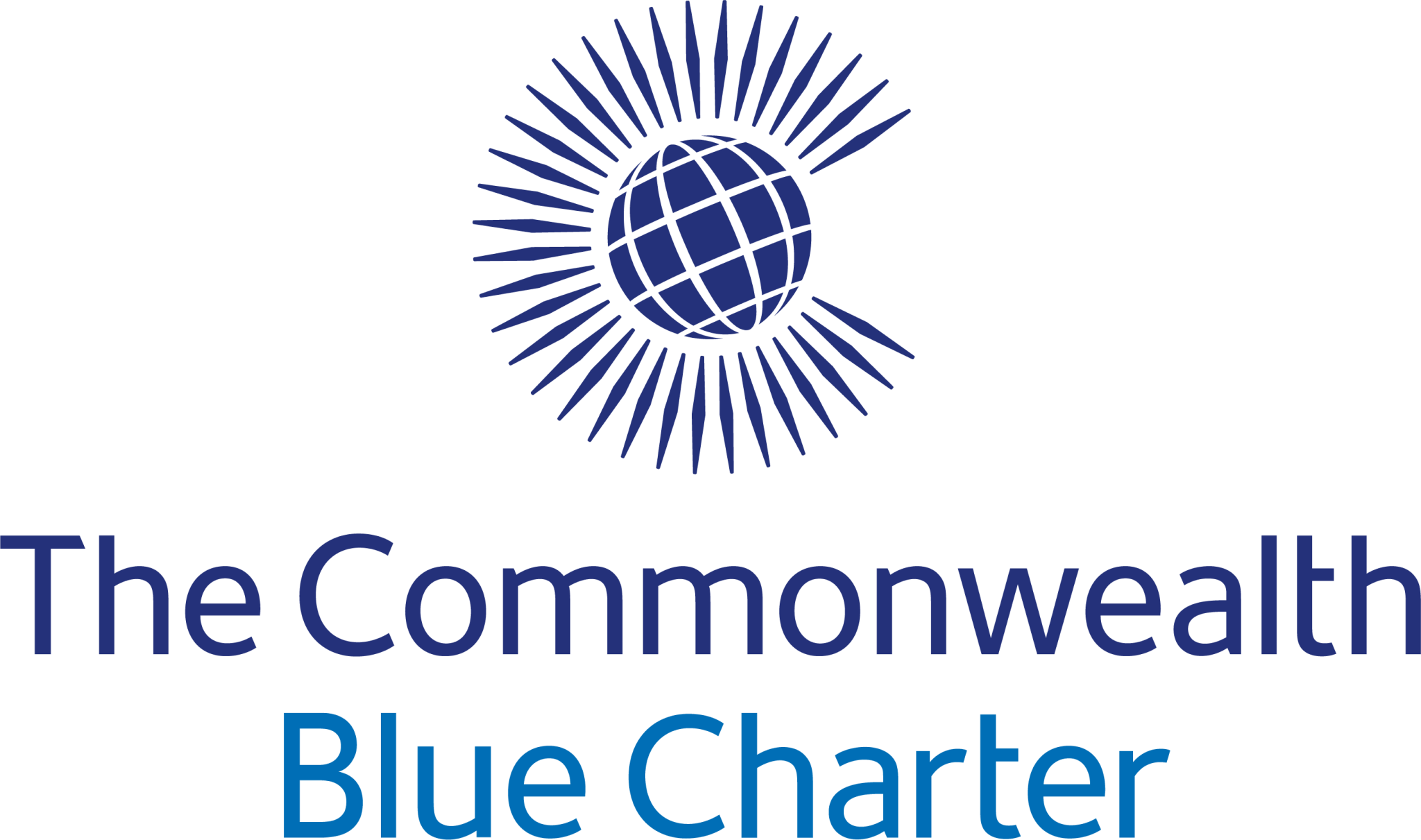 | 2022/01/08 | Website | |
| 2569 | Plan Vivo Standard, V5.0 | The Plan Vivo Standard is a set of requirements used to certify smallholder and community projects based on their climate, livelihoods and environmental benefits. It is the longest-standing carbon Standard in the Voluntary Carbon Market. |  | 2022/01/08 | Manual | |
| 2553 | Victorian Coastal Wetland Restoration Program | ArcGIS Story Map by the Blue Carbon Lab on the Victorian Coastal Wetland Restoration Program in the state of Victoria, Australia. |  | 2022/01/08 | Infographic | |
| 2205 | IPBC Knowledge Exchange 2 – Introduction to financing opportunities for blue carbon | This video features a virtual panel session and provides an overview of the different funding paths for blue carbon conservation and restoration activities, including the international carbon market, non-market mechanisms and innovative finance. | 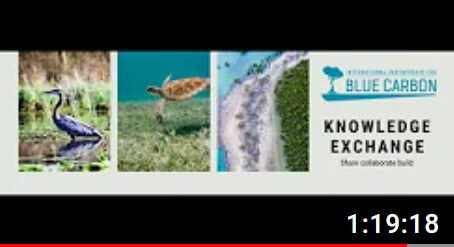 | 2022/01/08 | Video | |
| 2199 | IPBC Inventory of Blue Carbon Actors | The Inventory of Global Blue Carbon Actors which lists the main players in the blue carbon field including intergovernmental agencies, non-governmental organization or global initiative. |  | 2022/01/08 | Paper | More information |
| 2611 | Seagrass Community Outreach Video under the Coastal Wetlands and Climate Change Project (SeyCCAT) | Seagrass has been the main blue carbon ecosystem focus for the Coastal Wetlands and Climate Change Project since the project began in January 2020. There have been many community activities throughout the project and the team wanted to ensure it was captured, especially the approval of creole words for Seagrass and its 5 life forms. |  | 2022/01/08 | Video | |
| 2202 | IPBC Knowledge Exchange 1 – The Do’s and Don’ts of Successful Blue Carbon Projects | This video features a virtual panel session and provides an overview of the different types of blue carbon projects, i.e., conservation and various types of restoration, present methods, best practices and lessons learnt for the implementation of blue carbon restoration or conservation projects, which were designed to lead to carbon credits. | 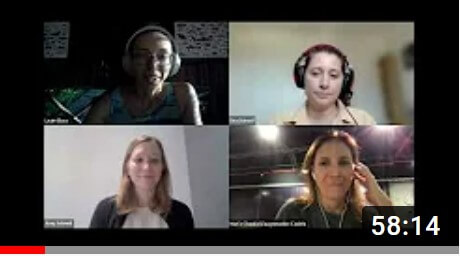 | 2022/01/08 | Video | |
| 2599 | The State of the World’s Mangroves | The State of the World’s Mangroves provides the very latest information on what we know about mangroves and what’s being done to support these magnificent habitats. |  | 2022/01/08 | Report | |
| 2596 | A National Blue Carbon Action Plan | Opportunities and recommendations for the US Administration and Congress prepared by Restore America’s Estuaries. |  | 2022/01/08 | Policy brief | |
| 2551 | Marine Protected Areas as Climate Solutions | ArcGIS Story Map by the US NOAA Marine Protected Areas Center showing how MPAs support climate resilience, mitigation and adaptation. |  | 2021/01/08 | Infographic | |
| 2592 | Blue Carbon: Integrating Ocean Ecosystems in Global Climate Action | An overview of blue carbon ecosystems and how they contribute to climate mitigation and adaptation. |  | 2021/01/08 | Policy brief | |
| 2584 | Investing for Ocean Impact | A podcast series on the reasons to invest in the ocean. |  | 2021/01/08 | Podcast | |
| 2581 | Ensuring the Sustainability of Blue Carbon Ecosystems | An introduction to the blue carbon initiatives being advanced in Japan. |  | 2021/01/08 | Paper | |
| 2577 | The Republic of Korea Ministry of Oceans and Fisheries’ 2050 Carbon Neutrality Scenarios | Massive wildfires, typhoons, heatwaves, and snowstorms caused by global warming have become almost a part of daily life and can be seen easily around the globe. Korea is not immune to such effects of global warming. In Korea, the rate of warming accelerated in recent years, with the average temperature rise for the past 30 years reaching 1.4°C, and the warming is expected to pick up more speed in the coming years. |  | 2021/01/08 | National policy | |
| 2576 | The Republic of Korea’s Enhanced Update of its First Nationally Determined Contribution | The enhanced update of the first NDC of the Republic of Korea is set at the most ambitious level possible to achieve the goal of carbon neutrality by 2050 despite the country’s manufacturing-oriented industry structure. |  | 2021/01/08 | National policy | |
| 2573 | The Blue Carbon Policy Training Course – Module 2 | The Blue Carbon Policy Training Course is designed to equip policy makers with the knowledge and skills to identify and develop blue carbon initiatives and projects. The course includes 8 engaging and accessible modules that build key capabilities through self-paced learning, recorded webinars, practical activities, and reflection questions. |  | 2021/01/08 | Video | |
| 2567 | Methodology for Tidal Wetland and Seagrass Restoration (VM0033) | This methodology outlines procedures to quantify net greenhouse gas emission reductions and removals resulting from project activities implemented to restore tidal wetlands. |  | 2021/01/08 | Manual | |
| 2559 | Coastal Wetlands in National Greenhouse Inventories | Advice on reporting emissions and removal from management of blue carbon ecosystems. |  | 2021/01/08 | Manual | |
| 2552 | Blue Carbon in Marine Protected Areas. | ArcGIS Story Map by the US NOAA Marine Protected Areas Center based on the report “Blue Carbon in Marine Protected Areas (Part 1 and Part 2)”. |  | 2021/01/08 | Infographic | |
| 2549 | Proceedings of the 2021 International Symposium of Blue Carbon | Proceedings of the 2021 International Symposium of Blue Carbon at the PEMSEA East Asian Seas (EAS) Congress 2021 and 2021 World Ocean Week in Xiamen, China. |  | 2021/01/08 | Conference proceedings | |
| 2805 | Manual for the Creation of Blue Carbon Projects in Europe and the Mediterranean | This manual intends to provide knowledge-based guidance for developing project-based interventions using the carbon finance mechanisms to improve seagrass and coastal wetland conditions for climate change mitigation and adaptation. Complementary to this, it can be used for other interventions such as addressing how to robustly quantify blue carbon stocks to identify gains and losses and inform national greenhouse gas inventories. |  | 2021/01/08 | Manual | |
| 2129 | Blue Carbon Policy Training Course – Module 5 | Module 5 looks at climate finance and carbon markets, and how these are relevant to blue carbon. | 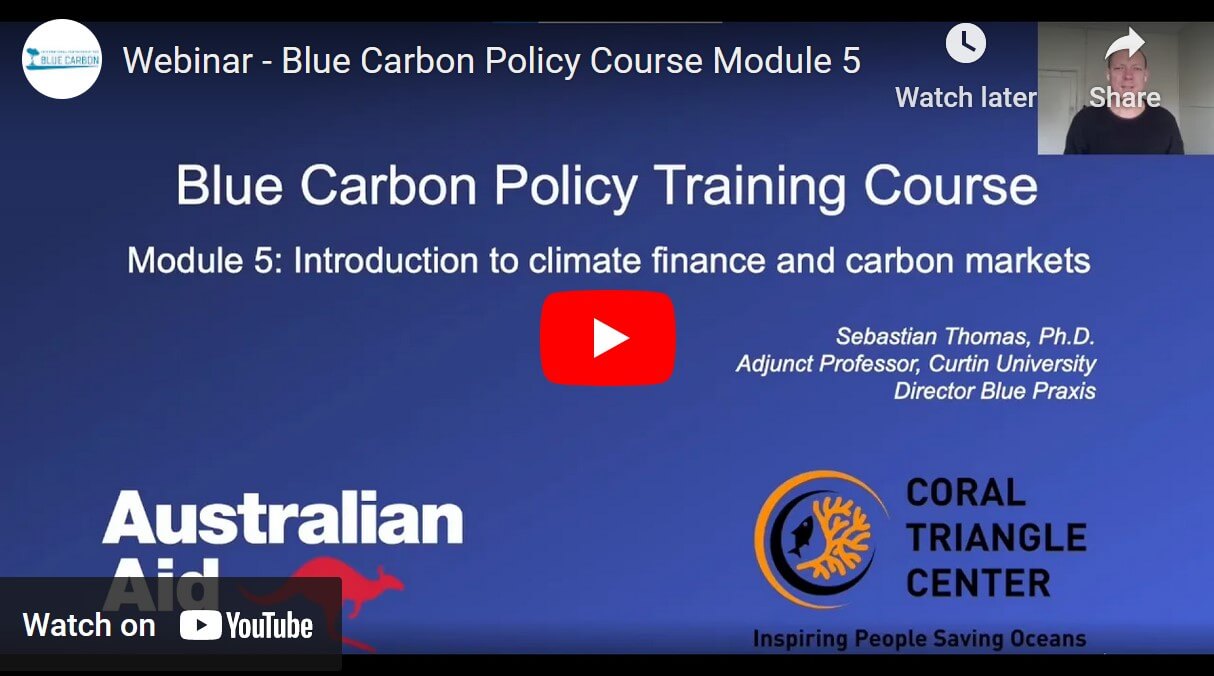 | 2021/01/08 | Video | |
| 2119 | Coastal Blue Carbon Ecosystems in International Frameworks and Conventions Overview Report | This document provides an overview of the main international frameworks and conventions that address the conservation, restoration, and sustainable use of coastal blue carbon ecosystems. | 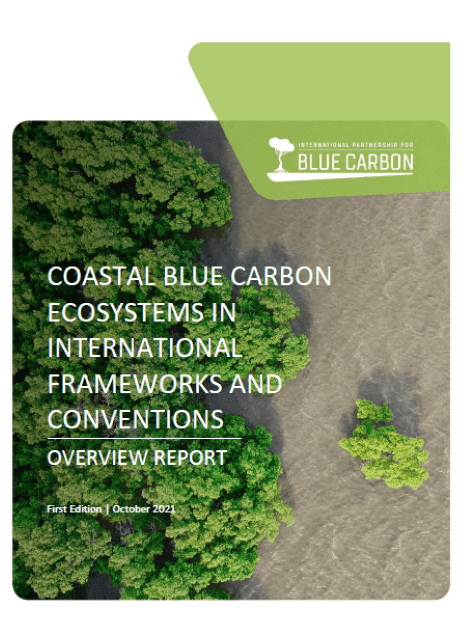 | 2021/01/08 | Report | More information |
| 2120 | Coastal Wetlands in National Greenhouse Inventories | By incorporating coastal wetland (or blue carbon) ecosystems into National Greenhouse Gas Inventories (NGGIs), countries can improve the continual monitoring and reporting of the condition of these ecosystems and recognise the valuable contribution they provide to climate change mitigation and adaptation. | 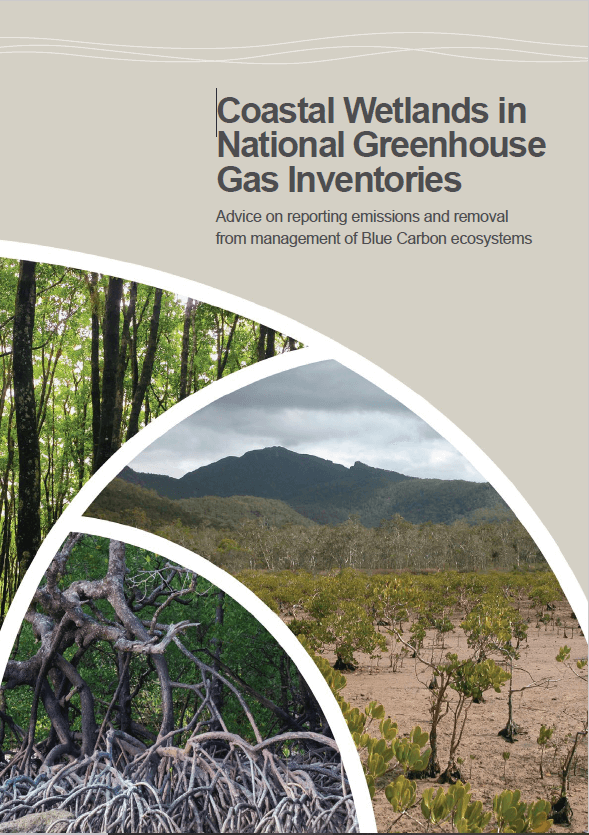 | 2021/01/08 | Manual | More information |
| 2616 | The first national scale evaluation of organic carbon stocks and sequestration rates of coastal sediments along the West Sea, South Sea, and East Sea of South Korea | This study reports current organic carbon stocks and sequestration rates in the coastal areas of West Sea, South Sea, and East Sea of South Korea, encompassing entire intertidal areas using long-term field survey combined with remote sensing technology. |  | 2021/01/08 | Paper | |
| 2612 | Mães do Mangue – Ep. 01 (Portuguese) | A campanha Mães do Mangue tem como ponto de partida as histórias de vida das mulheres extrativistas, da costa amazônica paraense, que tem os manguezais como lugar de orgulho e pertencimento. Elas e suas famílias têm uma atuação fundamental para mitigar a crise climática, propondo soluções comunitárias e se tornando verdadeiras guardiãs dos mangues brasileiros. |  | 2021/01/08 | Video | |
| 2610 | Restored mangrove forests in Perancak Estuary, Bali: 17 years of mangrove restoration in abandoned aquaculture ponds | This book highlights the milestones achieved over the 17 years of restoration of mangrove forests in Perancak Estuary, Indonesia (2004-2021). It also provides a synopsis of research and observation, public outreach and other activities related to mangrove ecosystem in the Indonesian Institute of Marine Research and Observation since 2004. |  | 2021/01/08 | Report | |
| 2606 | The Economic Value of America’s Estuaries | A report prepared by TBD Economics LLC and the Center for the Blue Economy. |  | 2021/01/08 | Report | |
| 2605 | Blue Carbon in Marine Protected Areas: Part 2. | This is a case study of the Greater Farallones National Marine Sanctuary, USA, which is part of a series to inform and guide MPA managers in the assessment, protection, and management of blue carbon habitats and processes. |  | 2021/01/08 | Report | |
| 2604 | Blue Carbon in Marine Protected Areas: Part 1. | This review is Part 1 of a series to inform and guide MPA managers in the assessment, protection, and management of blue carbon habitats and processes. |  | 2021/01/08 | Report | |
| 2600 | Global Wetland Outlook |  | 2021/01/08 | Report | ||
| 2595 | Realizing the full potential of marine and coastal wetlands: Why their restoration matters | A factsheet on how the Convention on Wetlands supports the restoration of marine and coastal wetlands. |  | 2021/01/08 | Factsheet | |
| 2580 | Catalyzing sustainable fisheries management through behaviour change interventions | A peer-reviewed article in Conservation Biology on the impact of a standardized small‐scale fisheries management intervention – Rare’s ‘Fish Forever’ program. |  | 2020/01/13 | Paper | |
| 2594 | The contribution of blue carbon ecosystems to climate change mitigation | Prepared by the Scientific and Technical Review Panel (STRP) of the Convention on Wetlands, this Briefing Note describes the spatial extent, ecological characteristics and condition of coastal blue carbon ecosystems across Ramsar sites. |  | 2020/01/08 | Policy brief | |
| 2587 | Mangroves: Amphibious defenders against extreme climate events (25 July 2020) | With Lola Fatoyinbo, physical scientist in the Biospheric Sciences Laboratory at NASA Goddard Space Flight Center; Steven Paton, Director of the Smithsonian Tropical Research Institute’s physical monitoring program; and Rosa Maria Roman-Cuesta, CIFOR’s tropical forest ecologist. |  | 2020/01/08 | Podcast | |
| 2586 | The carbon on your plate: mangrove and aquaculture (11 July 2020) | CIFOR Principal Scientist Daniel Murdiyarso and Matt McLuckie, director of Investor Relations at Planet Tracker explore the longstanding clash between mangrove conservation efforts and the aquaculture industry. |  | 2020/01/08 | Podcast | |
| 2585 | 10 Preguntas Para Entender Por Qué Necesitamos Más Manglares, Más Que Nunca (25 July 2020) (Spanish) | Tres científicos: Rosa Román de CIFOR, Miguel Cifuentes de CATIE y Jorge Herrera de CINVESTAD responden diez preguntas que aclaran la situación de los manglares en la región y el mundo, sus desafíos y oportunidades. |  | 2020/01/08 | Podcast | |
| 2583 | IORA Blue Carbon Hub YouTube channel | Webinars and training videos from the IORA Blue Carbon Hub. |  | 2020/01/08 | Playlist | |
| 2579 | The Science of Changing Behaviour for Environmental Outcomes | A literature review of the science of changing behaviour for environmental outcomes. |  | 2020/01/08 | Report | |
| 2563 | REDD+ Methodology Framework (VM0007) | This methodology provides a set of modules for various components of a methodology for reducing emissions from deforestation and forest degradation (REDD). This methodology is applicable to forest lands, forested wetlands, forested peatlands and tidal wetlands that would be deforested or degraded in the absence of the project activity. |  | 2020/01/08 | Manual | |
| 2598 | Out of the Blue: The Value of Seagrasses to the Environment and to People |  | 2020/01/08 | Report | ||
| 2588 | Blue carbon and peatlands and the role they play at climate talks (9 December 2019) | With Daniel Murdiyarso, CIFOR’s Principal Scientist, at UNFCCC COP25. |  | 2019/01/08 | Podcast | |
| 2578 | Strategies for Operationalising Nature-Based Solutions in the Private Sector | This white paper provides guidance to companies looking to adopt and scale nature-based solutions within their organizations. |  | 2019/01/08 | Paper | |
| 2557 | Guide to Including Nature in NDCs | A guide providing policy-makers with a checklist of information and accounting that is needed to fully consider nature as a part of a country’s Nationally Determined Contribution (NDC) to the Paris Agreement, plus national case studies and policy recommendations. |  | 2019/01/08 | Manual | |
| 2615 | Natural and anthropogenic signatures on sedimentary organic matters across varying intertidal habitats in the Korean waters | In this study, sedimentary organic matters in the typical intertidal areas of South Korea were investigated to address year-round monthly distributions and site-specific sources. |  | 2019/01/08 | Paper | |
| 2609 | Behaviour Change for Nature | This toolkit for practitioners comprises 15 behavioural strategies and numerous case studies. |  | 2019/01/08 | Manual | |
| 2608 | Behavior Change Interventions in Practice | This document serves as a complement to Rare’s literature review on behavior change interventions specific to the environmental sector, by covering the how of behavioral design. |  | 2019/01/08 | Manual | |
| 2602 | The Paris Agreement, Carbon Pricing & NCS | This report examines natural climate solutions in the context of carbon finance, corporate investment and land sector offsets. |  | 2019/01/08 | Report | |
| 2555 | Blue Carbon Policy Assessment Worksheet | Worksheet (A3 – 2 pages) of the IPBC “Blue Carbon Policy Assessment Activity”. |  | 2018/01/08 | Manual | |
| 2554 | Blue Carbon Policy Assessment Activity | A template for undertaking an assessment of the policy conditions impacting the health and resilience of coastal blue carbon ecosystems, and identifying pathways to ensure their long-term conservation for climate action. |  | 2018/01/08 | Manual | |
| 2548 | Promoting the conservation and wise use of intertidal wetlands and ecologically associated habitats | Resolution XIII.20 of the 13th Meeting of the Conference of the Contracting Parties to the Ramsar Convention on Wetlands “Wetlands for a Sustainable Urban Future” (Dubai, United Arab Emirates, 21-29 October 2018). |  | 2018/01/08 | Conference proceedings | |
| 2547 | Promoting conservation, restoration and sustainable management of coastal blue carbon ecosystems | Resolution XIII.14 of the 13th Meeting of the Conference of the Contracting Parties to the Ramsar Convention on Wetlands “Wetlands for a Sustainable Urban Future” (Dubai, United Arab Emirates, 21-29 October 2018). |  | 2018/01/08 | Conference proceedings | |
| 2131 | Blue Carbon Policy Assessment Activity Template | A template for undertaking an assessment of the policy conditions impacting the health and resilience of coastal blue carbon ecosystems. | 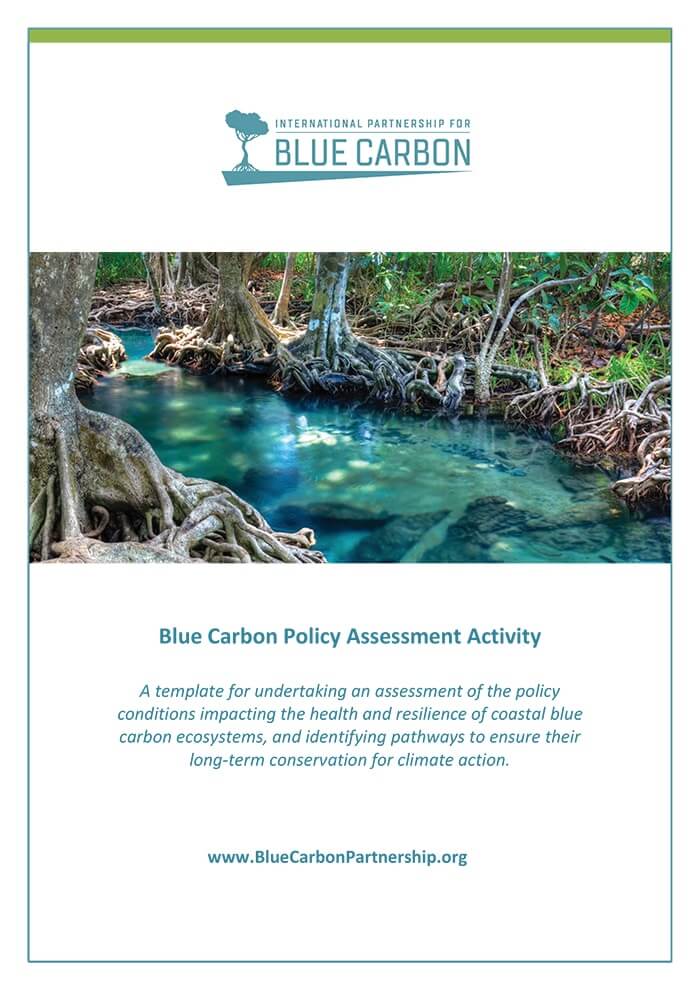 | 2018/01/08 | Manual | More information |
| 2132 | Blue Carbon Assessment Activity Worksheet | An A3 size worksheet to record information during a blue carbon assessment session | 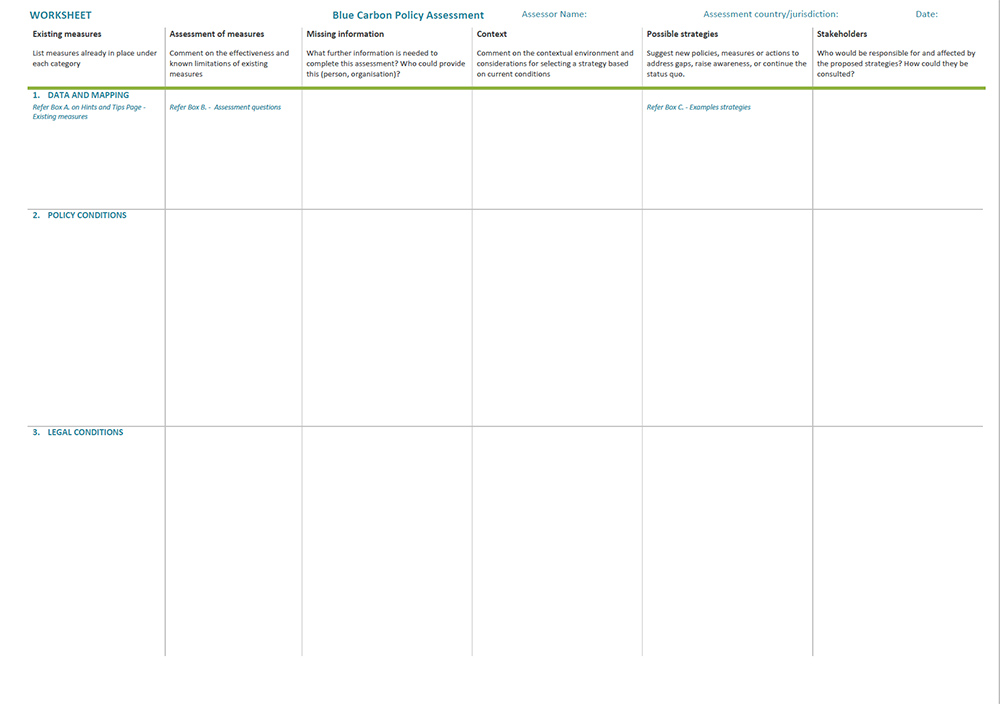 | 2018/01/08 | More information | |
| 2124 | Wetlands exchange – Lessons Learned | The Wetlands Supplement was scoped following recommendations from the Subsidiary Body for Scientific and Technological Advice of the UNFCCC in 2010 and 2011 when gaps in the | 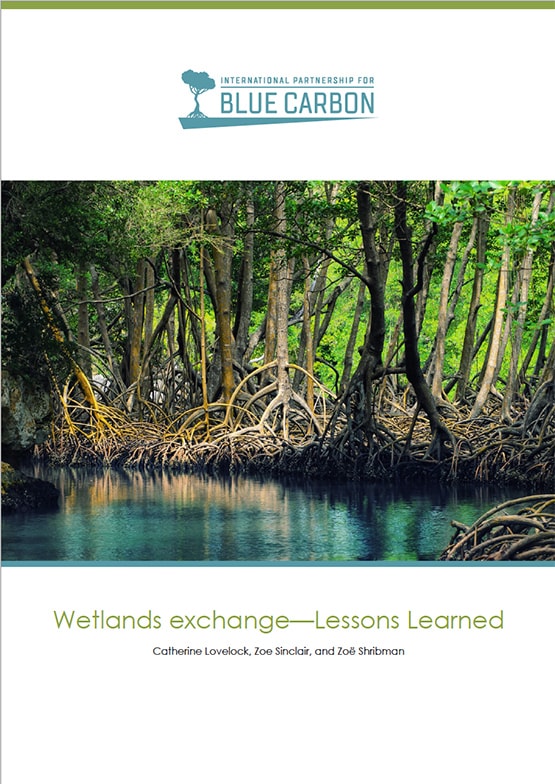 | 2018/01/08 | Report | More information |
| 2601 | Wetlands exchange – Lessons Learned | This document describes the outcomes of a workshop held by the International Partnership for Blue Carbon and University of Queensland in Brisbane, Australia, July 2018 that addressed the implementation of the IPCC 2013 Wetlands Supplement. |  | 2018/01/08 | Report | |
| 2568 | Methodology for Rewetting Drained Temperate Peatlands (VM0036) | This methodology outlines procedures to estimate the reduction of net greenhouse gas emissions resulting from project activities implemented to rewet drained peatlands in temperate climatic regions. It allows for the estimation of GHG emissions from drained and rewetted peatlands and also accounts for changes in carbon stocks in selected non-peat carbon pools. |  | 2017/01/08 | Manual | |
| 2603 | Understanding strategic blue carbon opportunities in East Asian region | This report seeks to better understand the status of coastal blue carbon ecosystems in East Asia and raise awareness of the opportunities to include improved management of these ecosystems within climate mitigation and adaptation actions and commitments, including opportunities to access new forms of financing. | 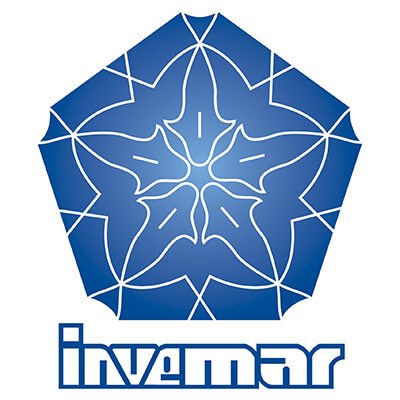 | 2017/01/08 | Report | |
| 2593 | Coastal blue carbon ecosystems. Opportunities for Nationally Determined Contributions. Policy Brief | This policy brief outlines how Parties have included coastal blue carbon ecosystems in their INDCs and NDCs (first round). |  | 2016/01/08 | Policy brief | |
| 2591 | Coastal blue carbon: An introduction for policy makers |  | 2015/01/08 | Policy brief | ||
| 2784 | Coastal Blue Carbon in Practice | A manual for using the VCS Methodology for Tidal Wetland and Seagrass Restoration (VM0033). |  | 2015/01/08 | Manual | |
| 2570 | Guiding principles for delivering coastal wetland carbon projects | This guidance document supports policy makers, coastal management practitioners and civil society organizations in designing projects and activities in coastal wetlands that synergize adaptation and mitigation objectives. |  | 2014/01/08 | Manual | |
| 2561 | Blue carbon manual | Manual by the Blue Carbon Initiative aimed at standardizing protocols for sampling methods, laboratory measurements, and analysis of blue carbon stocks and fluxes. |  | 2014/01/08 | Manual | |
| 2558 | 2013 IPCC Wetlands Supplement | The Wetlands Supplement extends the content of the “2006 IPCC Guidelines for National Greenhouse Gas Inventories” by filling gaps in the coverage and providing updated information reflecting scientific advances, including updating of emission factors. |  | 2014/01/08 | Manual | |
| 2556 | Blue Carbon and NDCs: Guidelines on Enhanced Action – 2nd Edition | Guidelines produced by the Blue Carbon Initiative to support countries with technical guidance on the multiple avenues for including blue carbon ecosystems within their Nationally Determined Contributions (NDCs) to the Paris Agreement. |  | 2014/01/08 | Manual, Report | More information |
| 2564 | Estimation of baseline carbon stock changes and greenhouse gas emissions from unplanned deforestation and unplanned wetland degradation (BL-UP) (VMD0007) | This module is part of VM0007 and allows for estimating carbon stock changes and GHG emissions related to unplanned deforestation and unplanned wetland degradation in the baseline scenario. |  | 2010/01/08 | Manual | |
| 2613 | The Blue Carbon Initiative Library | Peer-reviewed publications and reports by the Blue Carbon Initiative. |  | 2010/01/08 | Website |
